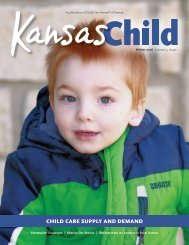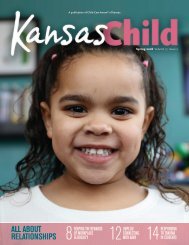2020 Spring Kansas Child
Create successful ePaper yourself
Turn your PDF publications into a flip-book with our unique Google optimized e-Paper software.
pials have enough independent mobility at
birth to crawl to the pouch and latch on. But
human infants, at birth, are neither physically
mobile nor, frankly, mentally fit for life.
We help make them so, or we don’t. Adult
responsibility for very young children is just
that straightforward…and that overwhelmingly
terrifying.
We—the adults who directly care for them,
along with our corporate and government
partners who make the policies that affect
their new lives—make them fit for life, or
we inadvertently create challenges. Neuroscience,
modern brain scanning technologies,
and a plethora of other research data have revealed
the definitive answer to the old Nature
vs. Nurture controversy. Yes, if you haven’t
read the books or seen the movies —spoiler
alert—it’s Nurture, hands down. We—their
families, communities, and governments—
help make a child into a good neighbor, or
we start him/her down the road to being an
unpleasant neighbor. And we get a significant
start on one of those outcomes in the first
three years of that child’s life.
We adults ensure that these most vulnerable
members of our species grow up connected to
us and each other in healthy relationships. We
ensure their access to the world as their natural
learning playground. Every single child brings
the only learning tool they’ll need for a long
time: an innate and self-perpetuating curiosity.
Nature does its part, definitely. Our gigantic
human brain holds awe-inspiring raw material:
100 billion neurons ready and waiting for
a connection to meaning. We start with about
as many brain cells as stars in the Milky Way;
almost all the neurons we will ever have. Yet,
they’re about as helpful as the box full of spare
connector cables each of us adults has in storage
somewhere. Unconnected, they just sit
there in a useless tangle, taking up space.
But not for long! Brain science has demonstrated
that every newborn’s 100 billion neurons
are wired together into patterns of learning,
meaning, and understanding in response
to experience, starting immediately at birth.
You look into an infant’s eyes, stroke its cheek,
or echo its laughter, and — zip-zappety-zap!
— those neurons in a useless tangle suddenly
connect. They “wire together” to form networks
in response to external events.
So, this might be news for you: you’re among
the wiring contractors and electricians deciding
how things get hooked up. And 85 percent
of the work is finished in each child’s new little
home of personality by the time they reach age
3. That’s right: we’re about 5 percent wired at
birth and 85 percent wired by 3.
This brain development isn’t directly about
how well a child is going to do in reading,
writing, and arithmetic. This early wiring is
mostly about a child’s personality, the
social and emotional understanding
each of us brings to our
daily interactions and relationships.
This development
is about the stuff that really
matters, because without
learning how to build and
live in mutually healthy relationships,
we can’t learn
much of anything else.
You don’t even remember 3,
but that’s where you, as You, really
started. Your personality’s feet were under
you, and you were standing on a firm foundation
for building a life…or they weren’t, and
you weren’t. Instead, you were staggering into
your preschool years, unprepared.
Quite literally, we adults can create infant
and toddler environments that wire a
child’s brain for trust, connection, empathy,
and continued voracious learning, in a world
that works for all of us. We DO know what
a quality start looks like for infants and toddlers;
thousands of early learning professionals
like me can design a developmentally supportive
environment for them.
Likewise, we know how to create environments
that wire brains for fear, isolation, disregard,
and disinterest, to create a world full of
conflict. Currently, the media often displays
stellar examples of such poor environments.
We begin to bring the former vision—of
trust and connection—into reality when we
create public policy that ensures healthy food
for all infants and toddlers, including adequate
workplace support for breast-feeding
moms. That still dependent little being is using
60 percent of its nutrition intake to feed
this rapidly developing brain (compared
to the 25 percent we adults use to feed our
brains). Access to family nutrition
programs, such as WIC
and SNAP, support these
L. CAROL SCOTT,
PhD
Author/Speaker
Nationally known as a thought-
leader whose work has shaped early
learning systems, Dr. Carol Scott has
consulted with government, nonprofit,
and philanthropic leaders on state systems
in Oklahoma, Georgia, Iowa, Kansas and
Missouri. Dr. Scott has worked at the leading
edges of development in our country’s
systems for quality rating and improvement,
professional development, and shared services
business models for the child care industry.
www.ks.childcareaware.org
5
















